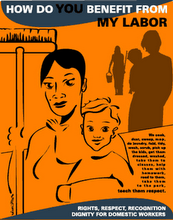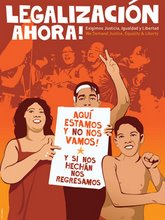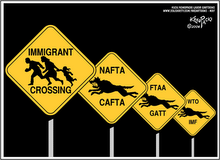
Expectations Mexican families increasingly crossed the border because higher-paying jobs never made their promised appearance.
THE North American Free Trade Agreement, enacted by Congress 14 years ago, held out an alluring promise: the agreement would reduce illegal immigration from Mexico. Mexicans, the argument went, would enjoy the prosperity and employment that the trade agreement would undoubtedly generate — and not feel the need to cross the border into the United States.
But today the number of illegal migrants has only continued to rise. Why didn’t Nafta curb this immigration? The answer is complicated, of course. But a major factor lies in the assumptions made in drafting the trade agreement, assumptions about the way governments would behave (that is, rationally) and the way markets would respond (rationally, as well).
Neither happened, yet Nafta remains the model for trade agreements with developing Latin countries, including the Central American Free Trade Agreement, passed by Congress in 2005. Three more Nafta-like agreements are now pending in Congress — with Panama, Columbia and Peru.
When Nafta finally became a reality, on Jan. 1, 1994, American investment flooded into Mexico, mostly to finance factories that manufacture automobiles, appliances, TV sets, apparel and the like. The expectation was that the Mexican government would do its part by investing billions of dollars in roads, schooling, sanitation, housing and other needs to accommodate the new factories as they spread through the country.
It was more than an expectation. Many Mexican officials in the government of President Carlos Salinas de Gortari assured the Clinton administration that the investment would take place, and believed it themselves, said Gary Hufbauer, a senior fellow at the Peter G. Peterson Institute for International Economics in Washington who campaigned for Nafta in the early 1990s.
“It just did not happen,” he said.
Absent that investment, foreign factories congregated in the north, within 300 miles of the American border, where some infrastructure already existed. “Monterrey is quite good,” Mr. Hufbauer said, “but in a lot of other cities the infrastructure is terrible, not even enough running water or electricity in poor neighborhoods. People get temporary jobs, but that is all.”
Meanwhile, Mexican manufacturers, once protected by tariffs on a host of products, were driven out of business as less expensive, higher quality merchandise flowed into the country. Later, China, with its even-cheaper labor, added to the pressure, luring away manufacturers and jobs.
Indeed, despite the influx of foreign-owned factories, total manufacturing employment in Mexico declined to 3.5 million by 2004 from a high of 4.1 million in 2000, according to a calculation of Robert A. Blecker, an American University economist.
As relatively well-paying jobs disappeared, Mexico’s average wage for production workers, already low, fell further behind the average hourly pay of production workers in the United States, and Mexicans responded by migrating.
“The main thing that would have stemmed the flow of people across the border was a rapid increase in wages in Mexico,” said Dani Rodrik, an economist and trade specialist at Harvard’s John F. Kennedy School of Government. “And that certainly has not happened.”
Something similar occurred in agriculture. The assumption was that tens of thousands of farmers who cultivated corn would act “rationally” and continue farming, even as less expensive corn imported from the United States flooded the market. The farmers, it was assumed, would switch to growing strawberries and vegetables — with some help from foreign investment — and then export these crops to the United States. Instead, the farmers exported themselves, partly because the Mexican government decided to reduce tariffs on corn even faster than Nafta required, according to Philip Martin, an agricultural economist at the University of California, Davis.
“We understood that the transition from corn to strawberries would not be smooth,” Professor Martin said. “But we did not think there would be almost no transition.”
A financial crisis also dashed expectations. One expectation was that the Mexican economy, driven by Nafta, would grow rapidly, generating jobs and keeping Mexicans home. The peso crisis of 1994-95, however, provoked a steep recession, and while there was some big growth later, the average annual growth rate over Nafta’s lifetime has been less than 3 percent.
The financial crisis struck just months after Nafta came into existence, undermining, early on, the Mexican government’s ability to spend money on roads, education and other necessary government functions.
“We underestimated Mexico’s deficits in physical and human infrastructure,” said J. Bradford DeLong, an economist at the University of California, Berkeley, and a Treasury official in the Clinton administration.
But, he says, without Nafta the migration would have been even greater. For instance, he says, there would not have been as much investment in the north of the country.
Finally, the steady flow of Mexicans to the United States has produced a momentum of its own — what Jeffrey Passel, a demographer at the Pew Hispanic Institute, calls a “network effect,” in which young Mexicans travel to the United States in growing numbers to join the growing number of family members already here.
The upshot is that Mexican migration to the United States has risen to 500,000 a year from less than 400,000 in the early 1990s, before Nafta, Mr. Passel estimates. Roughly 80 percent to 85 percent of immigrants are here illegally, he says.
The peso crisis, recession, the network effect — their impact may have been beyond anyone’s control, but not the assumptions about how the market and the government would act.
“We have indeed had one disappointment after another on this score,” Mr. Rodrik said, noting that the same assumption about government spending is part and parcel of the agreements, now before Congress, with Columbia, Peru and Panama.
While there is opposition to these proposals, it is mainly from Democrats who want a better safety net for American workers who might be hurt.
The European Union, in contrast, assumes little about government spending on the part of economically weaker nations joining it. The union itself has hugely subsidized the improved services needed by entering countries like Portugal, Spain, Greece and Poland, rather than leave financing to the relatively meager resources of entering countries.
The money is used not only for public investment, Mr. Rodrik noted, but also to subsidize companies setting up operations in the new countries and to support government budgets.
“I am not saying Nafta was a bad agreement,” Mr. Rodrik said. “But more than a trade agreement is required for countries to converge economically. And Nafta has been viewed as a shortcut to convergence without having to do all the other stuff.”















